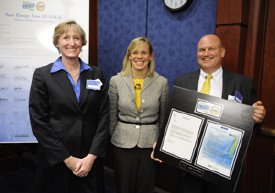Dec 11 2009
PPG Industries (NYSE:PPG) has joined the U.S. Department of Energy’s Save Energy Now LEADER Program, reinforcing the company’s voluntary efforts to significantly reduce its industrial energy intensity.
 Victoria M. Holt, PPG senior vice president, glass and fiber glass (left), participated in a Washington, D.C., signing ceremony along with Cathy Zoi, assistant secretary for energy efficiency and renewable energy, U.S. Department of Energy (DOE), and Jeffrey Walker, supervisor of partnership development and deployment for the Industrial Technologies Program in the Office of Energy Efficiency and Renewable Energy, DOE.
Victoria M. Holt, PPG senior vice president, glass and fiber glass (left), participated in a Washington, D.C., signing ceremony along with Cathy Zoi, assistant secretary for energy efficiency and renewable energy, U.S. Department of Energy (DOE), and Jeffrey Walker, supervisor of partnership development and deployment for the Industrial Technologies Program in the Office of Energy Efficiency and Renewable Energy, DOE.
In a Washington, D.C., ceremony on Dec. 2, Victoria M. Holt, PPG senior vice president, glass and fiber glass, and co-chair of PPG’s energy security and climate change committee, pledged to reduce PPG’s industrial energy intensity by 25 percent over the next decade. Charter members of the program agreed to establish energy use and energy intensity baselines and develop an energy-management plan over the next 12 months.
In December 2007, as part of its continued commitment to sustainable practices, PPG set a goal to reduce its total energy intensity by 25 percent from 2006 to 2016. Energy intensity is the number of million Btu per short ton of product manufactured. PPG is currently on track to meet this intensity goal, and in fact reduced its annual absolute global energy use by 5 percent in 2008.
“As part of our overall commitment to sustainable business practices, PPG is partnering with the Department of Energy to further our own energy-reduction goals and pursue greater energy efficiency and cost reduction,” Holt said. “We want to continue to advance our leadership in sustainability and demonstrate best practices for our peers, which will help to accelerate industry’s efforts as we continue to reduce our environmental impact.”
Some of PPG’s efforts to reduce energy consumption include a $242 million, 425-megawatt cogeneration power plant at PPG’s Lake Charles, La., chemicals complex that makes the plant twice as fuel-efficient as similar-sized facilities operated by electric utilities. Also, PPG was one of the first companies to install oxygen-fuel furnace technology on float glass and fiber glass production lines in North America and Europe. Today, this technology, which PPG now licenses to glass manufacturers around the world, reduces fuel consumption by 15 percent.
PPG is a member of the U.S. Environmental Protection Agency’s Climate Leaders program, which works with companies to develop comprehensive climate-change strategies. In addition, PPG has been recognized by the Climate Disclosure Project as a leader in emissions disclosure and reduction.